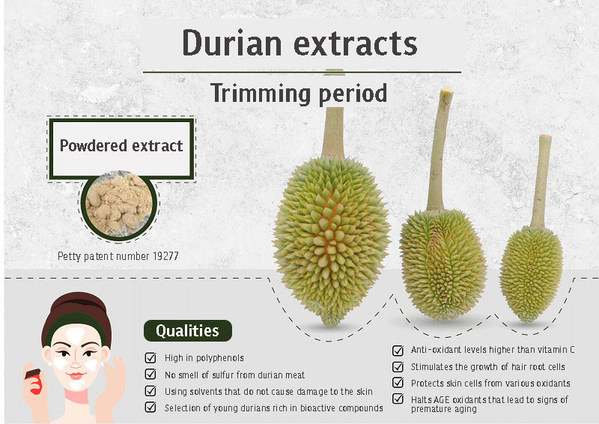Chula Faculty of Science researchers find young durian extracts to have as high anti-oxidants as vitamin C and aim to produce skin care products that add value to agricultural waste.
BANGKOK, Oct. 11, 2022 /PRNewswire/ -- The durian has been called the king of fruits, and Thailand's vital cash crop for booming export. Farmers usually need to trim off around 200-300 young durians per tree to relieve the excessive weight of the fruits, and generate tremendous agricultural waste in the process. So, the research team, led by Associate Professor Dr. Supaart Sirikantaramas of the Department of Biochemistry, Chula Faculty of Science, studied the young durians' biochemical composition and its potential use under the Bio-Circular-Green Economy (BCG) policy for Bio-economy.
The 6-12 centimeters long young durians (Durio zibethinus L.) produce a transparent slime when soaked in water. A metabolome analysis (all metabolites) found polyphenols which are very high in antioxidants, phenolics that can halt or delay the formation of oxidants, glycation to protect the skin from ultraviolet rays, and pectin which keeps the skin hydrated.
Putthamas Pewlong, a Master's Degree student in Biochemistry at the Faculty of Science, Chulalongkorn University, a team member, explained that extraction was done with biomarkers using no toxic solvents or heat. Divided skin cells were then cured in the extracts for 24 hours. Cells causing tension similarly found in dust or sunlight were then added. Results showed that the cells contain large numbers of live cells, similar to those treated with vitamin C. The extract was also found to induce an increase in cell divisions.
Skin toxicity was also tested, and found to be negative, rendering the extracts highly safe and can be used in cosmetics and skincare products.
The team then tried mixing the extract in powder form at 2-3% as prescribed by the FDA into sunscreen products on the market and found that the texture remained the same, and the pale-yellow tint of the extract is barely visible. The durian smell was also not detectable. It was also found that regardless of type, the young durians yielded similar levels of vital extracts.
Interested parties may contact Associate Professor Dr. Supaart Sirikantaramas at the Department of Biochemistry, Faculty of Science, Chulalongkorn University at Email: supaart.s@chula.ac.th.
For more information, visit https://www.chula.ac.th/en/highlight/83867/













